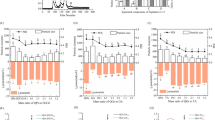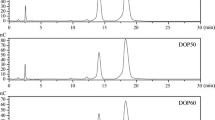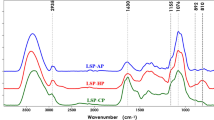Abstract
Chirata (Swertia chirata) is widely used in Indian folk medicine for the prevention of various disorders. Herein, we analyzed the water-extracted carbohydrate polymer (WECP) of this herb using chemical, chromatographic, and spectroscopic methods. The anti-oxidant capacity of this fraction was studied by ferric reducing anti-oxidant power (FRAP) and DPPH radical assays. Effect of WECP on bovine serum albumin spectrum (BSA) was determined using excitation wavelength of 282 nm. Anion exchange chromatography of WECP yielded 5 fractions (F1–F5) with different chemical compositions. The major fraction (F5) was homogeneous, had an apparent molecular mass of 4.5 kDa, and contains both carbohydrates (57%) and phenolics (34%). The anti-oxidant capacities of WECP and F5 were comparable to standard anti-oxidants. Notably, activities of the carbohydrate polymers (F1–F5) correlate with their phenolics content. Fluorescence quenching measurement suggests that F5 can form complex with BSA and the value of the binding constant is K=6.28×105/M.
Similar content being viewed by others
References
Finkel T, Holbrook NJ. Oxidants, oxidative stress, and the biology of aging. Nature 408: 239–247 (2000)
Mucke L. Alzheimer’s disease. Nature 461: 495–497 (2009)
Lee HB, Yu MR, Yang Y, Jiang Z, Ha H. Reactive oxygen species-regulated signaling pathways in diabetic nephropathy. J. Am. Soc. Nephrol. 14: 241–245 (2003)
Paz-Elizur T, Sevilya Z, Leitner-Dagan Y, Elinger D, Roisman L, Livneh Z. DNA repair of oxidative DNA damage in human carcinogenesis: Potential application for cancer risk assessment and prevention. Cancer Lett. 266: 60–72 (2008)
Hertog MGL, Sweetnam PM, Fehily AM, Elwood PC, Kromhout D. Antioxidant flavonols and ischemic heart disease in a welsh population of men: The caerphilly study. Am. J. Clin. Nutr. 65: 1489–1494 (1997)
Chaudhuri RK, Pal A, Jha TB. Regeneration and characterization of Swertia chirata Buch.-Ham. Ex Wall plants from immature seed cultures. Sci. Hortic.-Amsterdam 120: 107–114 (2009)
Chakravarty AK, Mukhopadhyay S, Das B. Swertane triterpenoids from Swertia chirata. Phytochemistry 30: 4087–4092 (1991)
Ishimaru K, Sudo H, Satake M, Shimomurat K. Phenyl glucosides from a hairy root culture of Swertia japonica. Phytochemistry 29: 3823–3825 (1990)
Menkovic N, Savikin-Fodulovic K, Bulatovic V, Aljancic I, Juranic N, Macura S, Vajs V, Milosavljevic S. Xanthones from Swertia punctata. Phytochemistry 61: 415–420 (2002)
Miana GA. Flavonoids of Swertia purpurascens. Phytochemistry 12: 728–729 (1973)
Reen RK, Karan M, Singh K, Karan V. Screening of various Swertia species extracts in primary monolayer cultures of rat hepatocytes against carbon tetrachloride- and paracetamol-induced toxicity. J. Ethnopharmacol. 75: 239–247 (2001)
Iqbal Z, Lateef M, Khan MN, Jabbar A, Akhtar MS. Anthelmintic activity of Swertia chirata against gastrointestinal nematodes of sheep. Fitoterapia 77: 463–465 (2006)
Chandra Sekar B, Mukherjee B, Chakravarti RB, Mukherjee SK. Effect of different fractions of Swertia chirayita on the blood sugar level of albino rats. J. Ethnopharmacol. 21: 175–181 (1987)
Tripathi R, Mohan H, Kamat JP. Modulation of oxidative damage by natural products. Food Chem. 100: 81–90 (2007)
Dubois M, Gilles KA, Hamilton JK, Rebers PA, Smith F. Colorimetric method for determination of sugars and related substances. Anal. Chem. 28: 350–366 (1956)
Ahmed A, Labavitch JM. A simplified method for accurate determination of cell wall uronide content. J. Food Biochem. 1: 361–365 (1977)
Blakeney AB, Harris P, Henry RJ, Bruce AB. A simple rapid preparation of alditol acetates for monosaccharide analysis. Carbohyd. Res. 113: 291–299 (1983)
Ghosh T, Pujol CA, Damonte EB, Sinha S, Ray B. Sulphated xylomannans from the red seaweed Sebdenia polydactyla: Structural features, chemical modification, and antiviral activity. Antivir. Chem. Chemoth. 19: 235–242 (2009)
York WS, Darvill A, O’Neill M, Stevenson T, Albersheim P. Isolation and characterisation of plant cell walls and cell wall components. Method. Enzymol. 118: 3–40 (1985)
Ishii T, Hiroi T. Isolation and characterization of feruloylated arabinoxylan oligosaccharides from bamboo shoot cell-walls. Carbohyd. Res. 196: 175–183 (1990)
Blakeney AB, Stone BA. Methylation of carbohydrates with lithium methylsulphinyl carbanion. Carbohyd. Res. 140: 319–324 (1985)
Huang D, Ou B, Prior RL. The chemistry behind antioxidant capacity assays. J. Agr. Food Chem. 53: 1841–1856 (2005)
Benzie IFF, Strain JJ. The ferric reducing ability of plasma (FRAP) as a measure of ‘antioxidant power’: The FRAP assay. Anal. Biochem. 239: 70–76 (1996)
Chattopadhyay N, Ghosh T, Sinha S, Chattopadhyay K, Karmakar P, Ray B. Polysaccharides from Turbinaria conoides: Structural features and antioxidant capacity. Food Chem. 11: 823–829 (2010)
Chatterjee UR, Bandyopadhyay SS, Ghosh D, Ghosal PK, Ray B. In vitro anti-oxidant activity, fluorescence quenching study, and structural features of carbohydrate polymers from Phyllanthus emblica. Int. J. Biol. Macromol. 49: 637–642 (2011)
Sinha S, Bandyopadhyay SS, Ghosh D, Chatterjee UR, Saha S, Ghosal PK, Ray B. Structural characteristics, fluorescence quenching, and antioxidant activity of the arabinogalactan protein rich fraction from senna (Cassia angustifolia) leaves. Food Sci. Biotechnol. 20: 1005–1011 (2011)
Fry SC. The Growing Plant Cell Wall: Chemical and Metabolic Analysis. Longman Scientific and Technical, Longman Group Ltd., London, UK. pp. 135–139 (1988)
Bassler GC, Silverstein RM. Spectrometric Identification of Organic Compounds. 2nd ed. John Wiley & Sons, New York, NY, USA. p. 98 (1963)
Humberstone AJ, Charman WN. Lipid-based vehicles for oral delivery of poorly soluble drugs. Adv. Drug Deliver. Rev. 25: 103–128 (1997)
Yuan XP, Wang J, Yao HY, Chen F. Free radical scavenging capacity and inhibitory activity on rat erythrocyte hemolysis of feruloyl oligosaccharides from wheat bran insoluble dietary fiber. LWT-Food Sci. Technol. 38: 877–883 (2005)
Jannin B, Menzel M, Berlot JP, Delmas D, Lancon A, La-truffe N. Transport of resveratrol, a cancer chemopreventive agent, to cellular targets: Plasmatic protein binding and cell uptake. Biochem. Pharmacol. 38: 1113–1118 (2004)
He XM, Carter DC. Atomic structure and chemistry of human serum albumin. Nature 358: 209–215 (1992)
Peters T. Serum albumin. Adv. Protein Chem. 37: 161–245 (1985)
Bourassa P, Kanakis CD, Tarantilis P, Pollissious MG, Tajmir-Riahi HA. Resveratrol, genistein, and curcumin bind bovine serum albumin. J. Phys. Chem. B. 114: 3348–3354 (2010)
Kragh-Hansen U. Structure and ligand binding properties of human serum albumin. Dan. Med. Bull. 37: 57–84 (1990)
Author information
Authors and Affiliations
Corresponding author
Rights and permissions
About this article
Cite this article
Ghosh, D., Bandyopadhyay, S.S., Chatterjee, U.R. et al. Carbohydrate polymers of chirata (Swertia chirata) leaves: Structural features, in vitro anti-oxidant activity and fluorescence quenching study. Food Sci Biotechnol 21, 409–417 (2012). https://doi.org/10.1007/s10068-012-0052-y
Received:
Revised:
Accepted:
Published:
Issue Date:
DOI: https://doi.org/10.1007/s10068-012-0052-y




